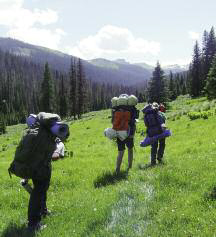Humility and Grandeur

Whenever I work with clients who want to make an artistic statement with their watershape or landscape designs, I commonly start by asking, “What’s your inspiration?”
That simple question cuts right to the heart of the matter: It prompts them to discuss their memories, preferences, influences and tastes while also encouraging them to think in artistic and even emotional terms about what they want. This gets them excited about the process – and gives me some much-needed guidance in working with them.
But there’s another side to the question of inspiration that’s equally important: As designers, we always need to be in touch with our own sources of inspiration and understand how they influence the work we do (or want to do).
In the ten-plus years I’ve been writing this column, I’ve covered dozens of books that have served me as sources of creative, artistic and professional inspiration. None of them, however, has been as important to me personally as has The Backpacking Guide to the Weminuche Wilderness, self-published by Dennis Gebhardts in 1974.
It’s long out of print and will most likely be impossible to find; moreover, it’s really of interest only to aficionados of backpacking in southwestern Colorado. Even so, I bring it up because no matter where you are or what wild territories you can access, I believe there is no substitute for traveling to places that inspire you.
As I sit here working on this column, I’m about to set forth on my twenty-ninth trip to the Weminuche Wilderness, where I lead groups of children and adults into the most beautiful acreage I’ve ever seen.
This year, 19 mostly teen-aged kids and five adults will spend a week with me, hiking a challenging 21-mile trail that crosses between 10,000 and 12,000 feet of elevation along the Continental Divide amid some of the grandest scenery anywhere. Designated as a U.S. Wilderness Area, the virtually untouched, 60-square-mile space is sits between Silverton and Durango and includes seven peaks rising above 14,000 feet. (In my visits, I’ve now reached the tops of five of them.)
I experience the deepest possible sort of humility in these excursions, but I perceive a tremendous sense of joy as well – especially when I see the lights switch on behind the eyes of the young people who’ve made the trip. There’s also the artistic inspiration I find here: The natural beauty of these peaks, forests and mountain streams cannot be conveyed in words.
Nor, I have learned, can they be easily translated into the work of human hands and minds!
I’ve always believed that the greatest achievements in watershaping are those that succeed in mimicking nature and I find myself powerfully drawn to the possibilities, but I also find myself steering lots of clients away from naturalistic approaches because I don’t believe the settings they’re working with will allow the illusion to succeed. As a result, although I’ve done a few projects with a naturalistic bent (including one for my own home), I’m often reluctant to go that way despite my clients’ wishes and my own passion.
I’ve spent so much time closely observing nature at its best, hiking through places of remarkable grandeur and beauty, that all nature-imitating projects end up on a microscope stage – and I almost always find them lacking when it comes to the details that make the difference. I continue to strive and have taken incredible numbers of photographs to document what I’ve seen for future reference, but ultimately I must confess to being a bit intimidated by my awareness of how these details look in the Weminuche Wilderness and other wild places.
As human beings, these experiences definitely show us our limits. In our work as designers, however, they offer layers of inspiration we can use to power our ideas and make us strive for incredible levels of excellence and achievement. Speaking for myself, getting out into nature in this way brings a joy and richness to my life that cannot be fully understood or expressed.
I also know that, one of these days, the right client and the right space will come along and I’ll put everything I’ve learned to use in the best possible way. Here’s hoping!
Mike Farley is a landscape architect with more than 20 years of experience and is currently a designer/project manager for Claffey Pools in Southlake, Texas. A graduate of Genesis 3’s Level I Design School, he holds a degree in landscape architecture from Texas Tech University and has worked as a watershaper in both California and Texas.










